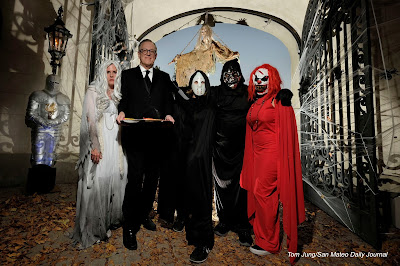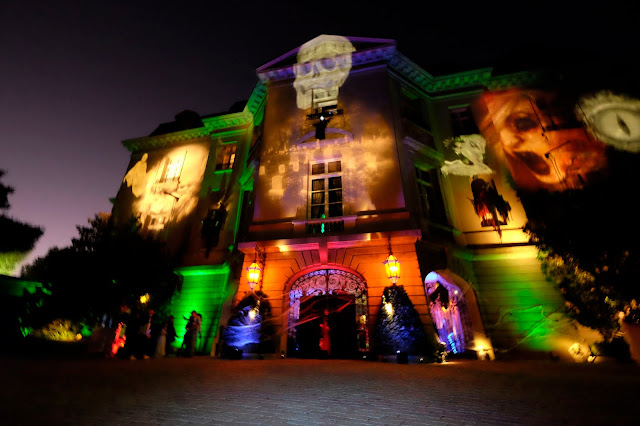 |
| 1/8 second, F 5.6, ISO 6400 |
 |
| 1/180, F 5.6, ISO 200. Lens F.L. 10mm (15 full frame equivalent) |
 I shifted my attention to the covered carriage entrance, a feature typical of mansions built in the early 1900s. Without the twilight sky as a background, I was free to boost the ISO values, which in turn effectively increased the effective power of my flashes. Because the ceiling was too tall for bouncing, I relied on a domed flash held aloft with a short monopod to provide some modeling of my subjects. I could also increase my exposure time to allow the ambient accents lights to "show their colors". Of course, those long exposure time resulted in some camera movement blur, but the portions of the image lit solely by the flash were much sharper. I doubt that anybody except another photographer would have noticed the blur.
I shifted my attention to the covered carriage entrance, a feature typical of mansions built in the early 1900s. Without the twilight sky as a background, I was free to boost the ISO values, which in turn effectively increased the effective power of my flashes. Because the ceiling was too tall for bouncing, I relied on a domed flash held aloft with a short monopod to provide some modeling of my subjects. I could also increase my exposure time to allow the ambient accents lights to "show their colors". Of course, those long exposure time resulted in some camera movement blur, but the portions of the image lit solely by the flash were much sharper. I doubt that anybody except another photographer would have noticed the blur.  |
| 1/8 second, F 5.6, ISO 6400 |
The photo at the top of the post is a variation on the image I actually submitted. I simply burned in the highlight created by the flash to draw the viewer's attention to my subject's face.
Future Refinements: If I had the freedom to do so, I would have used the lightstand and the tripod. If I waited until all of the guests had left, I would have had the freedom to do so, provided I didn't hold the staff too much past their bedtime. If I could have submitted the image electronically while on location (reception was a bit spotty), I could have stayed longer to further refine the shot. I could have probably convinced the entire crew to stay for one final group photo, one which I'm sure would have been "killer"!
Addendum: I found this sample image well after the posting was written, and it adds an additional level of exposure control.
Rear Curtain Flash Synchronization: The technique is called Dragging Shutter, which is when you use longer shutter speeds to properly expose ambient-lit background. It helped to create this image. As one of the lighting staff rushed past me, I made this exposure. The shadow that appears in his wake was created by setting the camera's flash synchronization to Rear Curtain. When so set, the flash fired just before the shutter closed. This lit my subject at the final moment of his movement across the frame.
When I looked more closely at the image, I liked the way the edge of the light fell off at the lower edge of the frame. It hides the hard shadow at my subject's feet, a sure indicator that I used a near-camera flash to achieve the effect. Had I used a light stand, I could have locked my flash position and had my subject move in and out of the light puddle. But as I said, using a light stand in so crowded an environment is an accident waiting to happen. If a future assignment allows me that luxury, I'll certainly remember that lighting the lower edge of the frame can be easily controlled.


